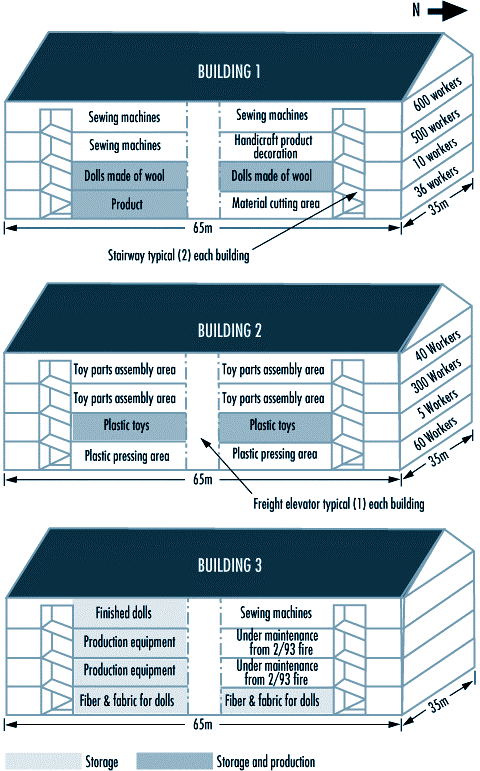Monday, May 10, was a normal workday at the
Kader facility. At approximately 4:00 p.m., as the end of
the day shift approached, someone discovered a small fire
on the first floor near the south end of Building One. This
portion of the building was used to package and store the
finished products, so it contained a considerable fuel load
(see figure 39.14). Each building at the facility had a
fuel load composed of fabric, plastics and materials used
for stuffing, as well as other normal workplace materials.

Security guards in the vicinity of the fire tried unsuccessfully
to extinguish the flames before they called the local police
fire brigade at 4:21 p.m. Authorities received two more
calls, at 4:30 p.m. and 4:31 p.m. The Kader facility is
just beyond the jurisdictional boundaries of Bangkok, but
fire apparatus from Bangkok, as well as apparatus from Nakhon
Pathom Province, responded.
As the workers and security guards tried in vain to extinguish
the fire, the building began filling with smoke and other
products of combustion. Survivors reported that the fire
alarm never sounded in Building One, but many workers grew
concerned when they saw smoke on the upper floors. Despite
the smoke, security guards reportedly told some workers
to stay at their stations because it was a small fire that
would soon be under control.
The fire spread rapidly throughout Building One, and the
upper floors soon became untenable. The blaze blocked the
stairwell at the south end of the building, so most of the
workers rushed to the north stairwell. This meant that approximately
1,100 people were trying to leave the third and fourth floors
through a single stairwell.
The first fire apparatus arrived at 4:40 p.m., their response
time having been extended because of the relatively remote
location of the facility and the gridlock conditions typical
of Bangkok traffic. Arriving fire-fighters found Building
One heavily involved in flames and already beginning to
collapse, with people jumping from the third and fourth
floors.
Despite the fire-fighters' efforts, Building One collapsed
completely at approximately 5:14 p.m. Fanned by strong winds
blowing toward the north, the blaze spread quickly into
Buildings Two and Three before the fire brigade could effectively
defend them. Building Two reportedly collapsed at 5:30 p.m.,
and Building Three at 6:05 p.m. The fire brigade successfully
kept the fire from entering Building Four and the smaller,
one-storey workshop nearby, and the fire-fighters had the
blaze under control by 7:45 p.m. Approximately 50 pieces
of fire apparatus were involved in the battle.
The fire alarms in Buildings Two and Three reportedly functioned
properly, and all the workers in those two buildings escaped.
The workers in Building One were not so fortunate. A large
number of them jumped from the upper floors. In all, 469
workers were taken to the hospital, where 20 died. The other
dead were found during the post-fire search of what had
been the north stairwell of the building. Many of them apparently
succumbed to lethal products of combustion before or during
the building's collapse. According to the latest information
available, 188 people, most of them female, have died as
a result of this fire.
Even with the help of six large hydraulic cranes that were
moved to the site to facilitate the search for victims,
it was several days before all the bodies could be removed
from the rubble. There were no fatalities among the fire-fighters,
although there was one injury.
Traffic in the vicinity, which is normally congested, made
transporting the victims to hospitals difficult. Nearly
300 injured workers were taken to the nearby Sriwichai II
Hospital, although many of them were transferred to alternate
medical facilities when the number of victims exceeded the
hospital's capacity to treat them.
The day after the fire, Sriwichai II Hospital reported
that it had kept 111 fire victims. The Kasemrat Hospital
received 120; Sriwichai Pattanana received 60; Sriwichai
I received 50; Ratanathibet I received 36; Siriraj received
22; and Bang Phai received 17. The remaining 53 injured
workers were sent to various other medical facilities in
the area. In all, 22 hospitals throughout Bangkok and Nakhon
Pathom Province participated in treating victims of the
disaster.
Sriwichai II Hospital reported that 80% of their 111 victims
suffered serious injuries and that 30% required surgery.
Half of the patients suffered only from smoke inhalation,
while the remainder also suffered burns and fractures that
ranged from broken ankles to fractured skulls. At least
10% of the injured Kader workers admitted to Sriwichai II
Hospital risk permanent paralysis.
Determining the cause of this fire became a challenge because
the portion of the facility in which it began was totally
destroyed and the survivors have provided conflicting information.
Since the fire started near a large electrical control panel,
investigators first thought that problems with the electrical
system might have been the cause. They also considered arson.
At this time, however, Thai authorities feel that a carelessly
discarded cigarette may have been the source of ignition.
|



